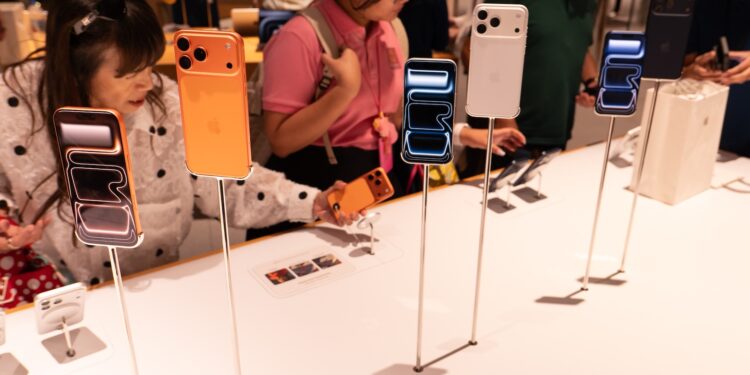The iPhone 17 is causing a stir in the global smartphone market. New figures from market research firm IDC show that Apple almost caught up with Samsung in market share in the third quarter of 2025. Strong demand for the iPhone 17 series, in particular, contributed to Apple selling significantly more devices than in the previous year. This is a remarkable development for the company in a challenging economic environment.
The iPhone 17 has quickly become one of the most successful models in Apple's history. Following its launch last month, demand already surpassed that of the iPhone 16 from the previous year. According to IDC, this success is due to a combination of technological advances, attractive financing models, and a consistent brand strategy. Despite rising prices and economic uncertainty, interest in premium smartphones remains unbroken – and Apple is benefiting more than most other manufacturers.
Apple is catching up with Samsung in market share
IDC estimates Apple's market share in the third quarter of 2025 at 18.2 percent, while Samsung continues to hold the lead with 19 percent. This puts Apple closer to Samsung than it has been in years. According to IDC data, Apple sold 58.6 million iPhones—a 2.9 percent increase compared to the same period in 2024. Samsung sold 61.4 million smartphones, a 6.3 percent increase year-on-year.
Strong demand for the iPhone 17 was a decisive factor. Pre-orders already significantly exceeded those of the predecessor model. The launch of the new model series last month gave Apple a clear growth boost, while many other manufacturers are reporting stagnant or declining numbers.
Innovation and financing as a recipe for success
IDC attributes the success of the iPhone 17 to three key factors: continuous technical innovation, a strong premium positioning, and flexible financing models. The combination of new hardware, improved software, and smart purchase incentives ensures that many consumers choose to upgrade, even in challenging economic times.
Programs like the iPhone Upgrade Program and generous trade-in offers play an important role in this. These financing models make it possible to acquire high-end devices without paying the full purchase price upfront. This makes the decision to buy a new model easier and keeps demand stable, even though premium smartphones can now cost between $800 and almost $2,000.
IDC Senior Research Director Nabila Popal calls this development "a remarkable achievement." She explains that manufacturers are innovating not only in hardware and software, but also in the way they design the purchasing process. According to Popal, they have "perfected the art of innovation not only in terms of technology, but also in removing barriers to purchase." Financing models and aggressive trade-in programs make the decision to upgrade "a no-brainer."
Market environment and economic factors
Despite global challenges and economic uncertainty, the smartphone market remains stable. IDC reports that the impact of the tariffs has been minimal so far. However, it remains unclear how strong demand would have been without these restrictions.
For Apple, however, a clear trend is emerging: The brand is able to retain and even expand its customer base even in a challenging environment. The iPhone 17 proves that continuous innovation and a clever marketing strategy pay off even when other manufacturers are struggling with declining demand.
- iPhone 17 Pro stays cool: All about the new vapor chamber
- AirPods Pro 3 vs. AirPods Pro 1: What's really changed
- Apple Watch Ultra 3 vs. Apple Watch Ultra 2: The Differences
- iPhone 17: Why this model is so convincing
- iPhone Air or iPhone 17 Pro? All the differences compared
- iPhone 17 vs. iPhone 16: All the differences in detail
- iPhone 17 Pro vs. iPhone 17 Pro Max: Differences at a glance
- iPhone Air: Seven facts about the new ultra-thin smartphone
- AirPods Pro 3: Apple's headphones with 8 exciting upgrades
- AirPods Pro 3 vs. AirPods Pro 2: The big comparison in detail
- Is the iPhone 17 Pro not worth it? The iPhone 18 Pro in focus
- Apple Watch Ultra 3 vs. Ultra 2, Series 11: Battery comparison
- iPhone 17 Pro: Everything about the new camera platform & more
iPhone 17 pushes Apple to the top of the smartphone market
In the third quarter of 2025, the iPhone 17 brought Apple closer to Samsung than it has been in years. Strong demand, technological advances, and flexible financing models have enabled the company to significantly increase its market share. While Samsung remains slightly ahead with a 19 percent market share, Apple is within reach at 18.2 percent – despite challenging economic conditions. IDC sees this development as a sign that Apple is successfully implementing its strategy of innovation, brand strength, and customer loyalty. If demand for the iPhone 17 remains at this level, Apple could soon take the lead in the global smartphone market. (Image: Shutterstock / Wongsakorn 2468)
- Apple TV has significantly more subscribers than expected
- Apple launches new clean energy projects in Europe and China
- All highlights of iOS 26.1 Beta 3 at a glance
- macOS 26.1 Beta 3 hints at a revised XDR display
- Apple presents eight AI studies at ICCV 2025
- iOS 26.1 Beta 3 brings hints of upcoming AI partners
- Apple TV gets a new app icon with iOS 26.1 & tvOS 26.1
- Apple TV+ is renamed – Apple TV is the new name
- F1 The Movie: From December 12, 2025 exclusively on Apple TV
- Apple confirms iPhone Air launch in China after delay
- Apple discontinues Clips app: End of a creative era





